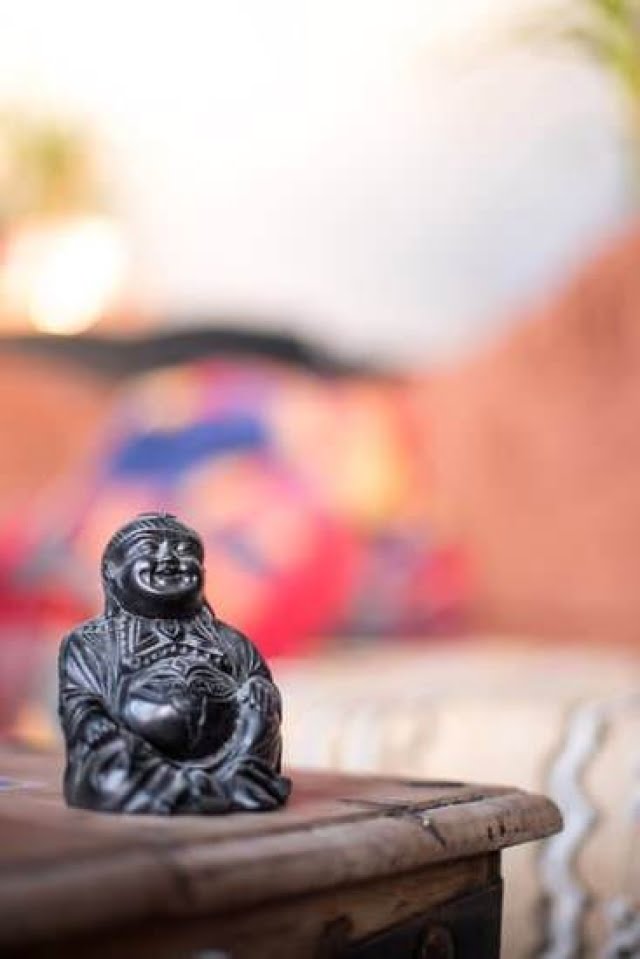Feng Shui Health Colors are a key component in the ancient Chinese art of Feng Shui, which is based on manipulating Chi (energy) into its most beneficial forms in order to improve quality of life. It is believed that strategically placing colors in one’s environment can produce a positive impact on health and overall well-being.
Understanding the properties of each of these health colors and how to incorporate them into your space will transform your home or office into a healing sanctuary that supports your highest vision.
Although red is commonly associated with love, passion and energy, it is said to have strong curative qualities according to Feng Shui principles. Red symbolizes fire and encourages courage, determination, strength and vitality. It has been known to help boost circulation, so it can be useful for those suffering from gout or arthritis; but beware that too much exposure may result in irritability or agitation.
Green represents balance and harmony, making it an excellent health color for promoting relaxation and wellbeing. Green brings peace of mind while also energizing the heart – after all, nature often has tremendous power over how we feel.
Since green encourages patience and stability, it can be used in any room you frequently experience stress or anxiety; for example, if you’re prone to panic attacks when working at home you should consider strategically placing some green accents around the area before starting any activity.
Blue is also very important when it comes to Feng Shui health color therapy as it helps bring calm and serenity to one’s life. Blue helps open us up emotionally speaking as well as mentally; it also helps generate trust between people since blue implies trustworthiness.
Therefore blue will prove beneficial if there are issues with communication within relationships or if someone needs help gaining confidence in themselves. Additionally blue can reduce depression symptoms as well as improve sleep patterns due to its soothing nature – this could be especially helpful for those who suffer from insomnia or other sleep-related problems.
Explanation of Feng Shui Basics and 5 Elements
Feng Shui is an ancient Chinese practice used to bring about health, wealth and good fortune of the people living within a specific space. It believes that the five elements, Wood, Fire, Metal, Earth and Water have a profound effect on our well – being.
The elements interact with one another to create a harmony of energy called ‘Qi’ which flow throughout the living environment. Understanding this balance of these natural elements is essential in creating a healthy life for us to absorb.
The Significance of Feng Shui Health Colors
Colors play an important role in Feng Shui as they are connected with each element and therefore influence the energy or Qi within them. Different colors represent moveable energy which helps connect us with nature and transform negative energy into positive illumination for our entire living environment.
Some colors are connected to certain natural elements like dark blue represents Water while green symbolizes Wood along with brown representing Earth and Yellow representing Fire. For each direction there is dedicated color options such as North is associated with Blue, South is represented by Red, East – Green, West – White & Center with Neutral Colours like White or Grey.
List Of Important Feng Shui Health Colors Affecting Each Element
- Wood Element – All shades of green, light beige
- Fire Element – Bright reds and yellows
- Earth Element – Peachy tones including apricot or terracotta
- Metal Element – Shades of white (silver), grey (steel) and gold
- Water Element – Dark blues and blacks.
Examples of Health Colors and How to Use Them to Refresh Your Home
Feng Shui health colors are considered to be an important part of creating a balanced and harmonious home environment. Utilizing the correct hues throughout your living space can help boost your wellbeing and improve energy flow in your home. Here are some examples of health color combinations that you can use to refresh your home:
- Vibrant Colors – Using vibrant colors like yellows, oranges, pinks, greens, blues and other bright hues can bring joyful energy into the home. Placing these colors in prominent areas of the home will ensure that they create an atmosphere of warmth and happiness in all rooms.
- Calming Colors – Calming colors such as whites, grays and pastels provide a soothing effect on both mind and body. Incorporating these colors in bedrooms or other areas where it is necessary to soothe frayed nerves is especially recommended.
- Bold Colors – Bold shades like purples, browns and deep reds have a bold yet calming effect that can help create an atmosphere of elegance and tranquility. Adding pieces featuring these shades to important areas throughout the home will add a touch of class without being overwhelming.
When decorating with Feng Shui health colors it’s important to pick out pieces that already match the desired color scheme or purchase accessories that can be used to pull together a cohesive look. For example if you want to utilize orange as your main health hue for an uplifting energy boost then choose furniture pieces and wall accents in this vibrant shade as well as adding plants or floral arrangements containing orange blooms.
Alternatively you could use colored lighting fixtures or art pieces featuring oranges tones for an effective contrast against neutral backdrops.
Incorporating Feng Shui colors correctly into your decorating plan allows you to completely overhaul any room in just minutes by swapping out old furniture pieces for trendy alternatives featuring refreshing health toned designs. By manipulating different combos you can easily reap all the benefits associated with enhanced Feng Shui inspirations without breaking the bank.
Examples of Health Colors for Self-Care and Stress Reduction
Feng Shui is a traditional Chinese system of beliefs that promotes living in harmony with the environment. Color is an essential component of Feng Shui, and colors can be used to both heal and improve health. Below are some health colors for self-care and stress reduction:
- Red – Red stimulates energy flow to physical organs, relieves fatigue, and aids blood circulation. It is a good color for invigorating, energizing, and enhancing personal power.
- Orange – Orange enhances focus, creativity, and nurtures healthy relationships. It symbolizes joy and warmth as well as brings happiness to the home.
- Yellow – Yellow signifies happiness and intellect. This color can bring clarity of thought as well as increase confidence.
In addition to these three primary health colors in feng shui, many other colors have healing properties. Light blue promotes healing on all levels while dark blue can be used to promote serenity. Green supports emotional wellness by bringing balance between heart and head energies while purple releases tension and encourages spiritual awareness.
Brightening up a room with fabrics or accessories in one of these hues can help detoxify energy while increasing vitality and focus – important when recovering from illness or injury or simply trying to stay healthy during stressful times. Different rooms often require different shades depending on feng shui’s five elements which include wood, fire, earth, metal and water; but generally focusing on lighter tones works best for aiding relaxation.
The key to creating restorative energy with feng shui lies in understanding how each color works with certain aspects of life. For instance, red has dynamic energy associated with passion or romance which makes it great for bedrooms whereas blue has calming vibes that make it beneficial for meditation practice areas like home spas or prayer spaces where you want stillness over stimulation.
Using Balance to Get the Most Out of Health Colors in Your Home
The practice of Feng Shui is the belief that the arrangement and energy of elements in our homes can be balanced in order to promote peace, happiness, and health. When it comes to creating a healthful living space, there are many colors associated with Feng Shui that can help.
Scientists have proven that certain colors can affect our emotions, energy levels, and even physical health. By incorporating these colors into your home décor or wardrobe through paint colors, furniture or clothing, you can benefit from their corresponding healthful qualities.
Health Colors
- Green: This color is believed to encourage calmness and stability as well as help with both physical and mental healing.
- Yellow: Yellow hues are purported to increase energy levels while also boosting confidence and concentration.
- Orange: Orange tones stimulate creativity and stimulate feelings of joy.
- Red: Considered to be an energizing hue, shades of red are believed to reduce fatigue while increasing vigor.
- Blue: Generally thought to reduce stress levels while helping improve communication skills.
- Purple: Used for centuries in spirituality due to its calming effects on the mind.
It is important when utilizing Feng Shui in your home to maintain balance. Too much or too little of any color can have negative effects on your mood. Try combining different tints and hues either within one object or several objects around the room. You can also bring balance using neutral walls as a backdrop for brightly-colored accessories. By harmonizing the different elements you will create a peaceful atmosphere conducive for good health.
Health Benefits of Using Colors in Your Home
The colors found in the home greatly affect not only your mood, but also your health. Colors can bring calmness and peace or provide a sense of grounding within a chaotic space. If carefully chosen, complementary colors can work together to create a harmonious energy in your space and bring order into disorder. The concept of Feng Shui centered around this idea of using elements, such as color, to create an energized positive living environment.
Colors that Encourage Health and Vitality
Feng Shui recommends certain hues to promote health and well-being. The thought is that vibrant and active colors, like reds, oranges and yellows will promote movement within a space which enhances creativity, productivity and quick decision making. Whereas more muted tones like blues and greens offer balance by soothing, calming worry while lifting the spirits promoting better sleep.
A Healthy Home Space with Painting
To best create your healthy living space incorporating colorful accent pieces or paintings allows for quick transformation without having to resort to expensive renovations such as changing the entire color scheme of the room. For example incorporating colorful paintings of nature scenes painted in warm tones or beach scenes painted in cool tones can help provide balance within a room without having to change furniture or repaint walls.
In order to assess what type of painting that would be best suited for each area within the home there are five key elements connected with Feng Shui painting selections: Metal brought forth via silver accessories; Wood present through green items; Fire represented in reds; Water visible through blues; And Earth seen through pastels colors (beige/brown). Additionally selecting plants can be beneficial their life force energy assists with providing lush greens into any environment creating freshness and mental clarity.
Stimulating Color Joyful Spaces
Color is an effective tool for any decor project since it affects our emotional state. It is recommended that lighter shades be used wherever mostly used such as kitchens or bedrooms whereas brighter hues should be kept for rooms with limited use such as an entryway or study areas.
As people move from one color hue to another spaces will feel different – warm tones leading toward a more inviting environment where one feels welcome whereas cooler tones add subtlety directing visitors deeper into an area helping them feel safe and secure.
Color Combinations to Avoid When Working with Health Colors
When working with health colors in feng shui, it is important to carefully consider the color combinations in order to attain a balanced and harmonious space. In some cases, certain combinations should be avoided as they are difficult to adjust or could potentially create a negative effect.
The color red is associated with courage, enthusiasm and strength in Feng Shui practice. It is an energizing color that also represents luck in the Asian culture. Red should not be combined with too many other colors as it can become too overwhelming, although some purples and blues may counterbalance its strong dynamic energy. Darker shades of red such as maroon or burgundy can have a calming effect if combined with lighter colors and white for a balanced look.
White symbolizes purity and innocence and is another popular choice among feng shui practitioners when designing spaces for health purposes. When used effectively, white provides a sense of clarity and peace of mind but when used incorrectly it could create boredom or listlessness-so careful consideration should be given when using this color.
White should be paired with earthy tones like brown or green and should never be mixed with too many other colors that could overwhelm it including vibrant yellows, oranges or reds.
Lastly, yellow indicates good vibes, joyfulness and mental clarity while also being an essential element for creating balance between yin (feminine) energy and yang (masculine) energy within a space. Yellow works well together with wood tones like brown or teal but should never be combined with deep blues or greys as this could easily create a dull look throughout the room.
Additionally because of its bright hue, yellow should never dominate too large of areas of any one space otherwise it could become distracting to those occupying the area negatively impacting the overall aura within the room.
Conclusion
Feng Shui health colors offer a variety of applications for improving the wellbeing of your home, and it certainly provides beneficial impacts to emotional and physical health. Different colors have various implications for establishing energy flow in the living space which can be extremely helpful in addressing health aspects such as stress levels from the comforts of your own home.
Furthermore, while color selection is typically depended on individual preference, feng shui with color theory generally requires a thorough understanding of their meanings so that they can be accurately applied to best suit one’s life style and promote balance into the arrangements.
Another great benefit that Feng Shui has to offer comes in the form of its approach for appealing to all five senses. Color being one of them, Feng Shi undeniably relies on designed approaches that surround us with physical beauty through our facility’s decorum.
One great example would be using warm colors like orange and yellow in an office or bedroom setting to give an informal yet inviting atmosphere while boosting energy levels. This subtle combination between comfortability and stimulating energy can create a very pleasant environment within any home or workplace making it a most suitable choice especially when working long hours inside of these rooms.
Overall feng shui health colors are more than just attractional additions to bedding placements or wall designs but also contribute to achieving balance in ones well being as so much emphasis is placed on detailed color selection over simple preference when applying this ancient technique within a modern lifestyle. One cannot underestimate how important it is for personal growth and navigating through emotional hardships but also make decisions towards healthy relationships outside one’s dwelling.

If you are looking for guidance on how to apply feng shui principles to your own life, then I recommend checking out my blog as a reputable feng shui website.





